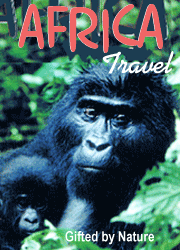 ...
... ..
..Uganda story ...Photos ...Photos 2 ... Photos 3... Photos 4
|
Uganda
Promotion Commonwealth
Heads of About
Uganda Good
Vibes Uganda
Profile Africa's
Emerald Mountains
of the Moon Air
Travel |
|
Uganda:
A Study in Development By
David A. Saunders Steps
to Success In
1987, Uganda adopted a structural adjustment
program and began a process to reenter the tourism
marketplace, seeking to develop a socially,
economically and environmentally beneficial tourism
program. The first step was to implement an
Integrated Tourism Master Plan, created in concert
with the United Nations Development Program and the
World Tourism Organization for the period 1992 to
2002. The ITMP envisaged dividing the country into
Primary (Rift Valley, Murchison Falls, and Kidepo
Valley); Secondary (Capital Area and the South West
Mountains); and Tertiary (Lake Mburo, Mount Elgon
and the Ssese Islands) zones. Specific programmes
of improvements to Uganda's tourism infrastructure
were proposed for each zone. Key marketing
objectives of the ITMP were to cooperate with
neighboring countries, develop a wide spread of
market segments, encourage off-peak traffic, extend
optimum stay, and attract high spenders. It was
widely accepted that Uganda's image was badly
damaged and in great need of rehabilitation. The
strategy was to target a public relations campaign
at the travel industry press, major tour operators,
travel writers, and special interest press and
television. In addition, the Uganda Tourism Board
was created as a result of the master plan. In
1997, Uganda launched the European Development Fund
Tourism Support Program to further expand upon the
guidelines of the ITMP. Tourism
Support Plan A
process of product definition identified and
assisted in the development of niche markets;
white-water rafting, bird watching, community based
tourism, chimpanzee trekking, gorilla trekking and
sport fishing. The plan also began the
rehabilitation of tourism in National Parks,
assisting Uganda Wildlife Authority in the
production of high quality guides to Murchison
Falls National Park, Kibale National Park and Bird
Watching. Other initiatives included creating a new
image for Uganda and marketing the "Uganda Trail"
locally, regionally and internationally as well as
fostering community tourism. By 2000, the World
Bank's Institutional Capacity Building &endash;
Protected Areas Management and Sustainable Use
initiative was instituted. One objective was to
facilitate a Governmental Tourism Policy for
Uganda. The policy came as a result of various
World Bank supported workshops and
seminars. Tourism
to Alleviate Poverty It
was decided that Uganda's tourism development
should be socially and culturally acceptable and
become a vehicle for poverty alleviation. Based on
a wide participation of Ugandan and foreign
investors, it should form the basis of protection
of the environment including financially supporting
National Parks. The policy targeted an annual
tourism increase from 10,000 to 50,000 tourists
within ten years providing an increase of revenue
by 60 million. The increase should be widely spread
in Uganda with participation at the local level.
Tourism would become a vehicle for economic
development with benefits widely spread and
economic linkages enhanced, encouraging ecotourism,
agro-tourism and community tourism products. The
private sector would be the driving force with the
public sector providing the enabling environment
and encouraging local development and
entrepreneurship. The private sector would enhance
its institutions and the government will put in
place the necessary regulatory framework for
development. In addition, a Uganda identity and
cultural pride would be encouraged including
cultural performances, handicrafts museums and
theaters. Competition
and Positioning Moreover,
in order for Uganda to successfully compete with
other African mainstream tourism products, it was
suggested that it focus on niche markets. Special
consideration will be given to ecotourism,
community tourism combining nature, culture and
local communities as well as adventure-sports
tourism. Tourism will also be incorporated into the
National Curriculum along with the Uganda Wildlife
Authority and Wildlife Clubs of Uganda being
supported to interlink wildlife education and
tourism issues and concerns. The Tourism Policy
document will also be distributed and focus-group
seminars conducted in order to promote tourism
awareness locally and nationally. The press and
Parliament will also be provided with
tourism-related information. Given the huge U.S
market, Uganda is putting special emphasis on
attracting investors. With over 22 million
inhabitants, ample natural tourism resources and an
economy in transition, Uganda offers great
potential for foreign direct investment. Uganda
also has one of the more established economies in
Africa with a well developed infrastructure and
many investment opportunities available in the
travel and tourism industry. Uganda
Sustainable Tourism Development Program's
objectives include image rehabilitation, improved
tourism products and services, widespread
discussion of tourism initiatives, stronger private
and public sector collaboration on tourism, more
communities benefiting from tourism and naturally,
more tourists and associated revenue. Uganda has
been able to achieve a remarkable comeback in the
past 15 years. More on this topic in our next
edition. UGANDA
BASED TRAVEL
& TOURS |
|||||||||||

 As
worldwide tourism expanded, however, Uganda's
tourism and tourism assets, went into decline.
During the fifteen years of Uganda's trauma, its
wildlife population was decimated, its tourist
accommodations neglected and its tourism
infrastructure left in disarray. It was during this
same period that the neighboring countries of Kenya
and Tanzania expanded and capitalized on their
tourism attractions. When Uganda finally re-entered
the tourism marketplace, it found that its
neighbors had dominated the East African tourism
scene, with Nairobi becoming the major
hub.
As
worldwide tourism expanded, however, Uganda's
tourism and tourism assets, went into decline.
During the fifteen years of Uganda's trauma, its
wildlife population was decimated, its tourist
accommodations neglected and its tourism
infrastructure left in disarray. It was during this
same period that the neighboring countries of Kenya
and Tanzania expanded and capitalized on their
tourism attractions. When Uganda finally re-entered
the tourism marketplace, it found that its
neighbors had dominated the East African tourism
scene, with Nairobi becoming the major
hub.
